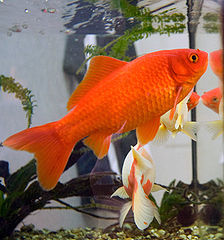Overview
Weatherfishes do not receive nearly the attention they deserve from aquarists, often being purchased as “curiosities” or “scavengers”. This is unfortunate, as they are among the most interesting of all fishes, and are very hardy as well. Their inquisitive dispositions and readiness to feed from the hand can only be described as “charming”. In part 2 of this article we will learn more about how to keep and enjoy them in the aquarium.
Two species are regularly available – the European weatherfish and the Oriental weatherfish (also sold as the dojo loach or Japanese weatherfish). The Oriental weatherfish is more commonly seen in the pet trade in the USA.
Physical Description
Weatherfishes have elongated, eel-like bodies with 5 pairs of fleshy barbels (sensory organs) surrounding the mouth. Their color ranges from metallic and golden tan through various shades of brown. The European species is striped, while the Oriental weatherfish is largely spotted, but both exhibit a mixed pattern of these markings. The Oriental weatherfish is also available in gold and albino color morphs.
Each can reach 12 inches in length, but rarely exceed 8 inches in the aquarium. I at first thought this was be due to a poor diet, i.e. their having to subsist upon “leftovers”. However, a number of individuals of both species that I have kept (including an Oriental weatherfish that reached age 21) also topped out at that length, despite being fed a diet rich in insects, snails and aquatic worms. I did see animals of 12-13 inches in a food market in a Chinese community in NYC. I was told that they had been imported from Hong Kong, but the store owner did not know whether they had been wild-caug ht or farm-raised. Perhaps, as with other fish species, local populations or races vary greatly in size.
ht or farm-raised. Perhaps, as with other fish species, local populations or races vary greatly in size.
Weatherfishes are classified as loaches, in the family Cobitidae. Many of the 118 species in this family of fresh water fishes, including the coolie loach, clown loach, yo-yo loach and hill stream loach, are popular with aquarists.
Range and Habitat
Both species have a huge range and are equally at home in many types of waterways. The European weatherfish favors rivers, streams and lakes, but is able to tolerate farm ponds and other less-than-ideal habitats as well. The Asian species is found in every type of fresh water environment imaginable. Due to its ability to take oxygen from the air, it is found in stagnant waters and does quite well in swamps, ditches and rice fields.
The Oriental weatherfish occurs from southern Russia south through India and China to Vietnam, Korea and Japan and has been introduced to Australia, Germany, the Philippines, Palau and the USA (Hawaii, California, Idaho, Indiana, Illinois). Much to the horror of loach fanciers, it is used as fish bait in some places, a fact that may in part account for the widespread feral populations. Detailed fieldwork has not been carried out with regard to introduced populations. However, as ravenous predators of invertebrates and fish eggs, it is suspected that they are negatively affecting local species. For this reason, weatherfishes are illegal to possess in Australia and England.
The European species occupies most of Europe except for Great Britain, Ireland, Scandinavia and Greece. Introduced populations have been found in Italy, Spain, Croatia and the USA (Great Lakes region and possibly elsewhere).
Diet
Both species feed largely upon insects, snails, worms and terrestrial invertebrates that fall into the water. They will also feed upon carrion and likely take fish eggs and fry as well.
Reproduction
Rising temperatures and water levels stimulate breeding in both species. Pairs perform “mating dance” of sorts during which the male wraps himself about the female and fertilizes the eggs as they are laid. The eggs are greenish in color and attach to plants and the substrate. No parental care is provided.
Miscellaneous
The weatherfish owes its common name to its unique habit of becoming very active just before a storm. This activity apparently is caused by the effects of barometric pressure (change in air pressure) upon the swim bladder. Weatherfish are among the earliest fish species to have been maintained in captivity – farmers in medieval Europe kept them for their weather predicting abilities, and in Japan they were much valued for their habit of swimming to the water’s surface prior to earthquakes.
Weatherfishes can breathe atmospheric oxygen, a facility that allows them to survive in swamps, rice fields and other habitats unsuitable for many fishes. Interestingly, they have evolved a respiratory system that is quite different than that employed by the “labyrinth breathers” (gouramis), lungfishes and other species that utilize air-borne oxygen. When breathing from the water’s surface, weatherfishes gulp air, absorb its oxygen within the gut and expel the excess via the anus.
During droughts, both species aestivate by burrowing into the mud, where they survive without water for quite long periods. Weatherfishes living in temperate areas spend the cooler seasons below the mud as well.
Please write in with your questions. I am very interested in hearing from you concerning the sizes your weatherfishes have reached, or if you have observed large individuals in food markets. Thanks, Frank.
An interesting article about introduced populations of the Oriental weatherfish (here and abroad) is posted at:http://www.thefreelibrary.com/New+records+for+the+alien+oriental+weatherfish,+Misgurnus…-a0162455040
 That Fish Blog – Aquarium Advice and Information
That Fish Blog – Aquarium Advice and Information




